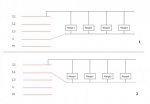regarding household cooking appliances section 220.55 :
wanna understand this sentence :
Where two or more single-phase ranges are supplied by
a 3-phase, 4-wire feeder or service, the total load shall be
calculated on the basis of twice the maximum number connected
between any two phases.
and i have this question too about the correct method of the following two ,to get max demand according to column c ,table 220.55 :
it it is required to calculate the max.demand of 23-single phase ranges each unit rating 15kw ,supplied by 3 ph system .
1 - the max demand will be = 39.5 kw at 23 unit .
this mean every phase will supply around 39.5/3= 13 kw .
2- but if the calculation use the units per single phase 23/3=8 unit
the max demand=24.5 per phase at 8 unit.
and max demand for all phases will be 24.5*3= 73.5 kw .
so which method is the correct one ?
wanna understand this sentence :
Where two or more single-phase ranges are supplied by
a 3-phase, 4-wire feeder or service, the total load shall be
calculated on the basis of twice the maximum number connected
between any two phases.
and i have this question too about the correct method of the following two ,to get max demand according to column c ,table 220.55 :
it it is required to calculate the max.demand of 23-single phase ranges each unit rating 15kw ,supplied by 3 ph system .
1 - the max demand will be = 39.5 kw at 23 unit .
this mean every phase will supply around 39.5/3= 13 kw .
2- but if the calculation use the units per single phase 23/3=8 unit
the max demand=24.5 per phase at 8 unit.
and max demand for all phases will be 24.5*3= 73.5 kw .
so which method is the correct one ?



